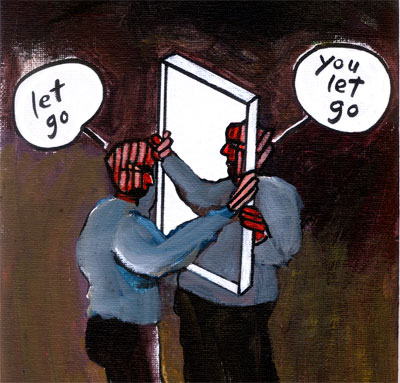 Every Saturday, we’ll be posting a new illustration by David Lester. The Mecca Normal guitarist is visually documenting people, places and events from his band’s 27-year run, with text by vocalist Jean Smith.
Every Saturday, we’ll be posting a new illustration by David Lester. The Mecca Normal guitarist is visually documenting people, places and events from his band’s 27-year run, with text by vocalist Jean Smith.
Riverdale, N.Y., 1965. Percy’s strange orange and pink landscapes are sealed behind a glossy surface—mysterious maps or aerial images of another planet’s surface—carefully lit to enhance the shine. Frank spends most weekends in his carriage-house studio working on several paintings at once, and in the final stage, he slathers them with Rhoplex, a plastic coating that, once completely dry, gives them the deep shine Percy requires. After the sun has gone down on the other side of the Hudson River, Percy sits and watches freshly slathered surfaces, milky cloud-cover while wet, turn transparent as they dry. Through the early part of an evening, with a chilled bottle of DuBonet and a slender box of Colt cigars that he swears up and down to Julia he isn’t inhaling, Percy can be found seated in a canvas and wood director’s chair watching the orange and pink surfaces return beneath the hardening layers of Rhoplex. In order to give the pronouncement—”Done! Finished! The end!”—which he does near the top of his lungs, the paintings needed to be 100 percent dry, at which time they are carried across the brick patio between the studio and the house, where space is made on a wall by taking down an existing painting, which then leans in the front hallway, waiting to be picked up and taken to Demetrius W Bratdorf, the small, but increasingly significant, SoHo gallery that represents Percy Sheldon MacLean. All of which five-year-old Frank MacLean might react to by saying, “What’s the W for, dad?”
Such comments send Percy into dark tunnels of anger, because a lot of his activity is supposed to impress his son, and Frank has a definite knack for letting Percy know that, point blank, it doesn’t. Percy wonders if his kid, who has him so tightly wrapped around his little finger, isn’t the true genius in the house. Yes, it’s Frank who gets the big reactions, not Percy. And in so few words, so effortlessly delivered, thinks Percy.
“I don’t know what the fucking W is for,” Percy bellows, stomping back across the brick patio to the carriage-house studio, leaving his family in relative peace and quiet, which does, in fact, suit Frank.
In the same way that Percy wields pencil on paper and brush on masonite to process his world, Frank is pre-disposed to work things out in the English language. And he’s good at it. Zingers. Man, can the kid deliver.
Percy can never think of any good titles for his paintings, while five-year-old Frank has a seemingly endless supply to offer. Maybe it isn’t the actual title per se, thinks Percy. Maybe he just likes how Frank sees his work. To Percy, they’re decorative panels, but the gallery staff implores him not to say that. Ever. When potential clients ask about his paintings, they want to know what they represent, what they mean. They wonder if they are supposed to be able to see something in them. Find something. These are the clients Percy steers clear of at his openings. The ones twisting their heads sideways, both ways, back and forth, all around, trying to find something, while practicing the art of not spilling their drink. There is a lot of sideways head twisting at Percy’s openings and it makes him nervous, his Hathaway shirt damp under his black suit jacket.
When cornered by gallery staff and herded over to a sale-in-progress to be introduced to a buyer, Percy, for once in his life, has nothing to say until he can covertly lean in to read the card mounted on the wall, and then, with great theatrical emphasis, he tells the buyer that it’s called Orange Path To Pink Sea or A Dotted Line Divides Them or My Sister Is A Big Baby, and while the painting is being reconsidered based on a few words, Percy slips back to the bar to order another martini and loosen his tie. No one except Percy and Julia know that a five-year-old kid is making up the titles.
When Frank calls a painting Pointy White Mountains, Percy has to ask. “White mountains, Frank? What am I missing?”
Frank, sitting in the director’s chair in Percy’s studio, shrugs and says, “I forget.”
For all the hoopla surrounding Percy Sheldon MacLean, the brilliant young art director at Q&M and promising new abstract painter, one important fact about him remains unknown—except to Julia and then to Frank, in whom Percy confides during an attempt to spend more time with his son, drunkenly waking him up to ramble at him after coming home late from the Hickory House.
To his eternal consternation and shame, Percy Sheldon MacLean has no mind’s eye. He is officially a fraud.






